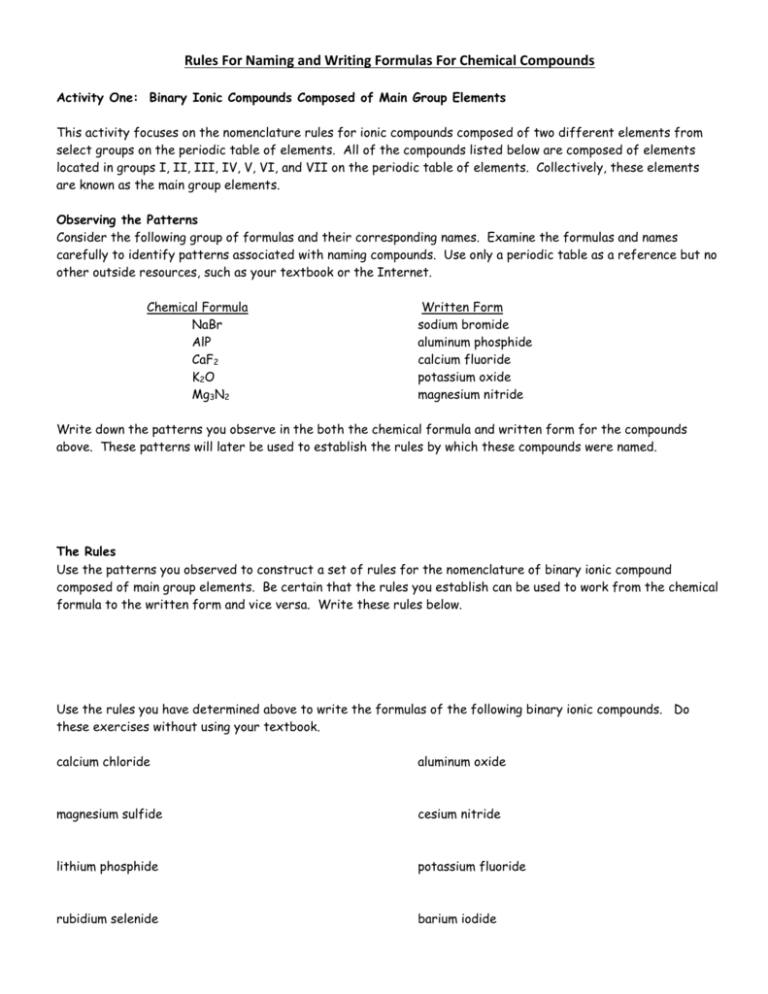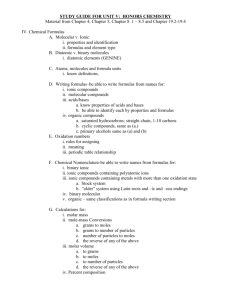The Rules - chemistry121
advertisement

Rules For Naming and Writing Formulas For Chemical Compounds Activity One: Binary Ionic Compounds Composed of Main Group Elements This activity focuses on the nomenclature rules for ionic compounds composed of two different elements from select groups on the periodic table of elements. All of the compounds listed below are composed of elements located in groups I, II, III, IV, V, VI, and VII on the periodic table of elements. Collectively, these elements are known as the main group elements. Observing the Patterns Consider the following group of formulas and their corresponding names. Examine the formulas and names carefully to identify patterns associated with naming compounds. Use only a periodic table as a reference but no other outside resources, such as your textbook or the Internet. Chemical Formula NaBr AlP CaF2 K 2O Mg3N2 Written Form sodium bromide aluminum phosphide calcium fluoride potassium oxide magnesium nitride Write down the patterns you observe in the both the chemical formula and written form for the compounds above. These patterns will later be used to establish the rules by which these compounds were named. The Rules Use the patterns you observed to construct a set of rules for the nomenclature of binary ionic compound composed of main group elements. Be certain that the rules you establish can be used to work from the chemical formula to the written form and vice versa. Write these rules below. Use the rules you have determined above to write the formulas of the following binary ionic compounds. Do these exercises without using your textbook. calcium chloride aluminum oxide magnesium sulfide cesium nitride lithium phosphide potassium fluoride rubidium selenide barium iodide Use the rules you have determined to write the names of the following binary ionic compounds. Do these exercises without using your textbook. SrCl2 BaO Na2S Cs3N LiI MgF2 K 3P CaSe Activity Two: Binary Ionic Compounds Containing Variably Charged Metal Ions A portion of the nomenclature system was introduced in Activity One and used to name binary ionic compounds composed of main group elements. However, there are numerous binary ionic compounds that contain metals capable of possessing more than one possible charge as a cation. This activity builds upon the previous experiences of converting observed patterns in both chemical formulas and written forms into a set of rules that can be used to name all types of binary ionic compounds. Observing the Patterns Consider the following group of formulas and their corresponding names. Examine the formulas and names carefully to identify patterns associated with naming compounds. Use only a periodic table as a reference but no other outside resources, such as your textbook or the Internet. Chemical Formula Fe2O3 FeCl2 PbS AlP CuF2 SnI4 KBr Written Form iron(III) oxide iron(II) chloride lead(II) sulfide aluminum phosphide copper(II) fluoride tin(IV) iodide potassium bromide Write down the patterns you observe in the both the chemical formula and written form for the compounds above. These patterns will later be used to establish the rules by which these compounds were named. The Rules Use the patterns you observed to construct a set of rules for the nomenclature of all binary ionic compounds. Be certain that the rules you establish can be used to work from the chemical formula to the written form and vice versa. Write these rules below. Use the rules you have determined above to write the formulas of the following binary ionic compounds. cobalt(III) oxide iron(III) chloride copper(II) bromide lithium arsenide chromium(III) sulfide lead(IV) iodide potassium nitride iron(II) phosphide Use the rules you have determined to write the names of the following binary ionic compounds. MnF2 Ni3P2 PbO2 Cs2S ScCl3 MgI2 PbS CuSe Activity Three: Ionic Compounds Containing Polyatomic (Complex) Ions The chemical nomenclature system was introduced in Activity One and further developed in Activity Two. Both of these activities limited themselves to ionic compounds composed only of two elements, or binary ionic compounds. Activity Three introduces polyatomic, or complex, ions. A complex ion forms when two or more atoms are covalently bonded together and do not have a stable electronic structure. To attain stability, the complex has also either lost (1 case, NH4+)) or gained electrons, acquiring a charge. This activity builds upon the previous experiences of converting observed patterns in chemical formulas and written forms into a set of rules that can be used to name all types of ionic compounds. Here is a list of common polyatomic ions: *ammonium nitrate sulfate carbonate phosphate acetate hydroxide cyanide hydrogen carbonate or bicarbonate NH4+ NO3SO42CO32PO43C2H3O2- or CH3COO OHCNHCO3- *NH4+ is the only positive complex ion we will work with. Do not confuse it with the molecular compound ammonia, NH3. Observing the Patterns Consider the following group of formulas and their corresponding names. Examine the formulas and names carefully to identify patterns associated with naming compounds. Use only a periodic table as a reference but no other outside resources, such as your textbook or the Internet. Chemical Formula (NH4)2S CoSO4 Fe(OH)3 Ca3(PO4)2 NH4NO3 Written Form ammonium sulfide cobalt (II) sulfate iron (III) hydroxide calcium phosphate ammonium nitrate Write down the patterns you observe in the both the chemical formula and written form for the compounds above. These patterns will later be used to establish the rules by which these compounds were named. Write formulas and names for the following compounds. Don’t forget to use parentheses around the formula for a complex ion if more than 1 complex ion is needed in the formula # cations # anions 1. 2 NH4+ ions 1 SO42- ion 2. 2 Al3+ ions 3 O2- ions 3. 1 Ca2+ ion 2 CH3COO- ions 4. 1 Fe3+ ion 3 NO3- ions 5. 1 Hg2+ ion 2 OH- ions Formula Name Complete the following chart # # Cations Cation # Anions Anion 6. NH4+ PO43- 7. Ba2+ NO3- 8. Cu+ S2- 9. Al3+ CO32- 10. Sr2+ OH- Formula Name Write formulas for the following compounds. I- OH- S2- CrO42- PO43- K+ NH4+ Mg2+ Al3+ Sn4+ Cu2+ Use the rules you have determined in this activity to write the formulas of the following ionic compounds. iron(III) acetate aluminum hydroxide strontium sulfate lead(II) sulfate copper(I) sulfide ammonium nitride potassium cyanide magnesium carbonate Use the rules you have determined to write the names of the following binary ionic compounds. Cu(OH)2 Sn(C2H3O2)2 Zn3(PO4)2 Pb(NO3)2 NaHCO3 NiCO3 NH4F MgSO4 Writing Names and Formulas for Binary Molecular Covalent Compounds This activity focuses on learning how to write names and formulas for binary (2 atom) compounds composed of nonmetallic elements (elements from the right hand side of the stair step on the periodic table). Observing the Patterns Consider the following group of formulas and their corresponding names. Examine the formulas and names carefully to identify patterns associated with naming molecules. Use only a periodic table as a reference but no other outside resources, such as your textbook or the Internet. Write down the patterns you observe in the both the chemical formula and written form for the compounds above. These patterns will later be used to establish the rules by which these compounds were named. Chemical Formula NF3 NO NO2 N2O N2O4 CO2 CO Written Form Nitrogen trifluoride Nitrogen monoxide Nitrogen dioxide Dinitrogen monoxide Dinitrogen tetroxide Carbon dioxide Carbon monoxide Determining the rules The Rules Use the patterns you observed to construct a set of rules for the nomenclature of all binary ionic compounds. Be certain that the rules you establish can be used to work from the chemical formula to the written form and vice versa. Write these rules below. Use the rules you have determined to write the formulas of the following molecules. carbon dioxide dihydrogen monoxide phosphorus triiodide sulfur dichloride boron trifluoride dioxygen difluoride phosphorus pentachloride sulfur hexafluoride Use the rules you have determined to write the names of the following molecules. N2H4 OF2 SBr2 BCl3 XeF4 ClF3 P4O3 CS2




